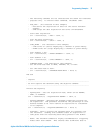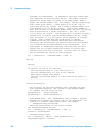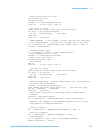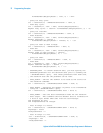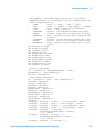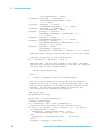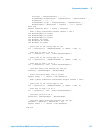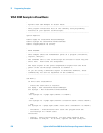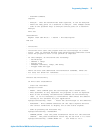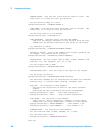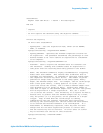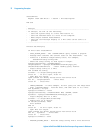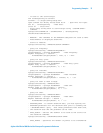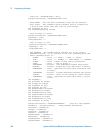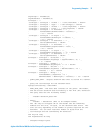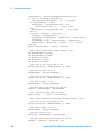Programming Examples 9
Agilent InfiniiVision 5000 Series Oscilloscopes Programmer's Reference 579
' DIGITIZE command.
Capture
' Analyze - Once the waveform has been captured, it can be analyzed.
' There are many parts of a waveform to analyze. This example shows
' some of the possible ways to analyze various parts of a waveform.
Analyze
Exit Sub
VisaComError:
MsgBox "VISA COM Error:" + vbCrLf + Err.Description
End Sub
'
' Initialize
' -------------------------------------------------------------------
' Initialize will start the program with the oscilloscope in a known
' state. This is required because some uninitialized conditions could
' cause the program to fail or not perform as expected.
'
' In this example, we initialize the following:
' - Oscilloscope
' - Channel 1 range
' - Display Grid
' - Timebase reference, range, and delay
' - Trigger mode and type
'
' There are also some additional initialization commands, which are
' not used, but shown for reference.
' -------------------------------------------------------------------
Private Sub Initialize()
On Error GoTo VisaComError
' Clear the interface.
myScope.IO.Clear
' RESET - This command puts the oscilloscope into a known state.
' This statement is very important for programs to work as expected.
' Most of the following initialization commands are initialized by
' *RST. It is not necessary to reinitialize them unless the default
' setting is not suitable for your application.
myScope.WriteString "*RST" ' Reset the oscilloscope to the defaults.
' AUTOSCALE - This command evaluates all the input signals and sets
' the correct conditions to display all of the active signals.
' Same as pressing the Autoscale key.
myScope.WriteString ":AUTOSCALE"
' CHANNEL_PROBE - Sets the probe attenuation factor for the selected
' channel. The probe attenuation factor may be set from 0.1 to 1000.
myScope.WriteString ":CHAN1:PROBE 10" ' Set Probe to 10:1.



